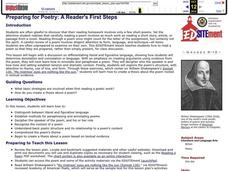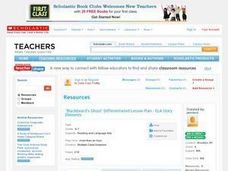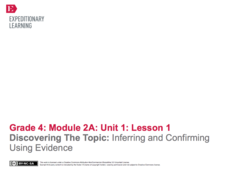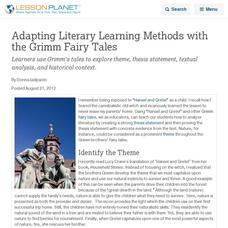Curated OER
Preparing for Poetry: A Reader's First Steps
Students examine denotation and connotation in language, and paraphrase a poem. They read and analyze a sonnet by iam Shakespeare, analyze the attitude and tone, paraphrase a poem, and create a thesis about a poem based on textual evidence.
Curated OER
"Blackbeard's Ghost" Differentiated Lesson Plan
Develop a better understanding of "Blackbeard's Ghost" with this differentiated lesson. Working in groups on a creative project, middle schoolers can reinforce their reading comprehension and literary analysis skills. Use this lesson to...
Curated OER
Excerpt from Elizabeth Gaskell's Mary Barton (1848)
Answering document-based questions is a great way to build reading comprehension and critical thinking skills. Learners read an excerpt from Elizabeth Gaskell's Mary Barton, then answer two related questions.
Curated OER
Neolithic Revolution
Use the provided passages on the Neolithic Revolution to answer 2 critical-thinking questions. Passage one is informational and describes benefits that came from the Neolithic Revolution. Passage two is a first person narrative from a...
Curated OER
Analysis Of Theme In The Scarlet Letter
Eleventh graders engage in the reading of the novel "The Scarlet Letter" while choosing a topic to write a literature response. They search the novel for textual evidence to include in writing a paper that supports a well thought...
Curated OER
The Effects of Slavery
The emotional and spiritual oppression of slavery in the African-American experience is the focus of this instructional activity. Middle schoolers analyze various texts by Frederick Douglass and Maya Angelou related to freedom and...
Curated OER
Introducing Jane Eyre
"How can a magazine reflect a particular time and culture?" Using this prompt, your class explores the Victorian Era as it relates to Charlotte Bronte's Jane Eyre. They can also play the "Victorian Women's Rights" game for the year 1840...
K12 Reader
"How Do I Love Thee?" Supporting Ideas
Show your class what poem the famous line "How do I love thee? Let me count the ways" comes from. Class members read Elizabeth Barrett Browning's poem and respond to one question with a short paragraph. The question asks learners to use...
EngageNY
Discovering the Topic: Inferring and Confirming Using Evidence
Allow your class to figure out what they will be studying through an inquiry-based anticipatory set that involves analysis of mystery documents and practice with making inferences. The lesson plan document includes a detailed description...
English Linx
Textual Evidence Worksheet
Perfect for a unit on characterization and simple enough to use with any text. Your class will practice the Common Core standard of citing textual evidence to support their analysis by first making an assertion about a character from a...
K12 Reader
Finding Text Evidence: Frederick Douglass
After reading a very brief excerpt from Frederick Douglass' autobiography, learners cite textual evidence to support a main idea of the primary source about Douglass' humiliating experience with slavery. This is a brief exercise that...
Read Works
Textual Analysis Lesson: Boys vs. Girls: It's Not Just in Your Head
The main characters in Bridge to Terabithia do no quite live up to their gender expectations. Explore this idea with a reading passage called "Boys vs. Girls: It's Not Just in Your Head." Included in the plan are detailed instructions...
E Reading Worksheets
Tone Worksheet 5
A speaker's attitude toward his or her subject matter determines the tone of a piece of literature. Interpret the tone of four different poems, as well as their meanings, with supporting textual details.
EngageNY
Grade 9 ELA Module 2: Unit 1, Lesson 9
Continue analyzing literature using textual evidence with a lesson on "I Felt A Funeral, in my Brain" by Emily Dickinson. Ninth graders bring their annotation skills and knowledge of figurative language from the previous eight sessions...
EngageNY
Grade 9 ELA Module 3, Unit 1, Lesson 5
Ninth graders study the study of animals in an informational text lesson plan that focuses on analyzing text structure. As learners continue reading the first chapter of Temple Grandin's Animals in Translation, they form inquiries and...
EngageNY
Grade 9 ELA Module 3, Unit 1, Lesson 6
Are cattle prods beneficial for herding cattle, or do they cause more harm than good? Investigate Temple Grandin's claim about animal behavior with a lesson that focuses on pages 20-23 of the first chapter of her book, Animals in...
Curated OER
End-of-Year Practice Test (Grade 11 ELA/Literacy)
Set up a solid foundation for learners going into Common Core testing by taking some time to complete this practice test. Class members answer questions about both literary and informational texts, with an emphasis on textual evidence....
EngageNY
Character Analysis: Resilience
A Three Threes in a Row note catcher enables class members to dig deeper into the theme in Unbroken. They work with partners for 10 minutes and then rotate around the room to work with others. After regrouping and class discussion,...
Curated OER
Shakespeare's Romeo and Juliet: 'You Kiss by the Book'
Students explore Shakespeare's Romeo and Juliet. In this analysis lesson, students recognize the use of poetic conventions as a principle of dramatic structure after analyzing the sonnetShakespeare created for the first meeting between...
Polk Bros Foundation
I Can Identify/Infer Motive
Why do people and characters act as they do? Require your class figure out the motivation of two people or characters they read about in a given text. In the short charts, pupils note down who, what they do, and why they do it. After...
C.S. Lewis Foundation
Study Guide to Letters to Malcolm
C.S. Lewis outlines in his final book Letters to Malcolm: Chiefly on Prayer, the struggle of what happens during prayer, and the purpose of the action. The resource provides two sets of questioning. The first furnishes deep textual...
EngageNY
Grade 9 ELA Module 2: Unit 1, Lesson 3
Hearken! and observe how well a literary analysis unit can help ninth graders read closely and connect text structure to a central idea. Focusing on Edgar Allan Poe's "The Tell-Tale Heart," learners take notes and track the development...
Curated OER
Adapting Literary Learning Methods with the Grimm Fairy Tales
Learners use Grimm's tales to explore theme, thesis statement, textual analysis, and historical context.
Curated OER
Declaration of the Rights of Man
As your historians examine the French Revolution, have them read "Declaration of the Rights of Man" in its entirety; it's not very long, and it gives them a great authenticity to understanding the efforts of the French people. After...
Other popular searches
- Close Textual Analysis
- Textual Analysis Text Features
- Textual Analysis of Poems
- Textual Analysis of Tam
- Textual Analysis of Tkam

























